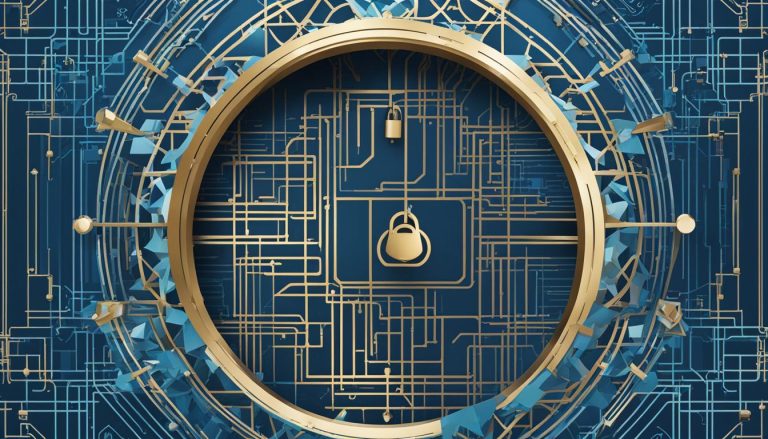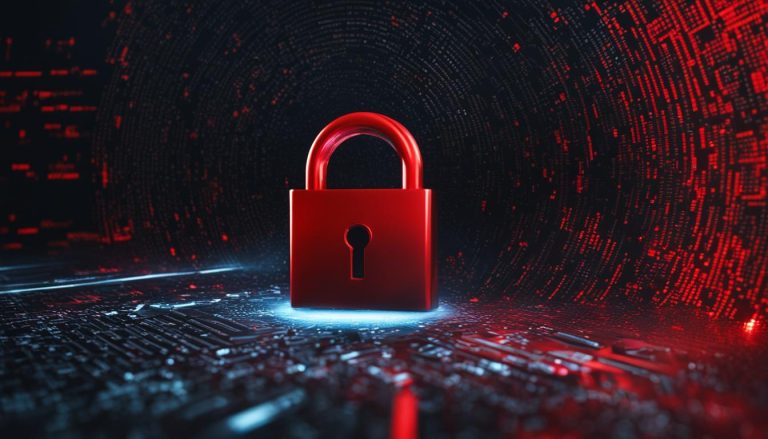As technology advances, so do the threats to our digital security. It’s more important than ever to ensure that our sensitive information remains protected from unauthorized access and cyber attacks. This is where Multi-Factor Authentication (MFA) comes into play.
MFA is a security measure that goes beyond the traditional username and password login method. It requires users to provide multiple forms of identification in order to access their accounts or complete transactions. By adding an extra layer of security, MFA helps safeguard our digital lives.
Key Takeaways:
- Multi-Factor Authentication (MFA) requires multiple forms of identification for access.
- MFA enhances security and reduces the risk of unauthorized access and cyber attacks.
- Benefits of MFA include improved security response and the ability to undertake digital initiatives confidently.
- Organizations can choose from knowledge-based, possession-based, and inherence-based MFA methods.
- Implementing MFA methods ensures the security of digital systems and protects sensitive information.
How does Multi-Factor Authentication work?
Multi-Factor Authentication (MFA) works by implementing multiple layers of identification to verify the user’s identity. This added security measure goes beyond the traditional username and password combination, making it harder for unauthorized individuals to gain access to sensitive information. MFA requires users to provide two or more forms of identification, which can include something they know, something they have, or something they are.
One common method of MFA is Two-Factor Authentication (2FA), where users must provide two distinct types of identification. This could be a combination of a password (something they know) and a unique code sent to their mobile device (something they have). Two-Step Verification is another variation of MFA, combining a password with an additional verification factor, such as a security question or biometric data.
For example, when a user attempts to log in to an online account, they may be prompted to enter their password (something they know) and then provide a unique, temporary code sent to their smartphone (something they have). By requiring multiple forms of identification, MFA significantly strengthens the security of the authentication process and provides an additional layer of defense against unauthorized access.
Multi-Factor Authentication Methods
| Method | Description |
|---|---|
| Knowledge-based | Users provide information only they would know, such as answers to security questions. |
| Possession-based | Users utilize something they have, such as a physical hardware token or a virtual authenticator app, to verify their identity. |
| Inherence-based | Biometric data, such as fingerprints or facial recognition, is used to authenticate the user. |
Organizations can choose to implement one or a combination of these methods to create a multi-layered approach to authentication. By incorporating different factors of identification, organizations can enhance their security and minimize the risk of unauthorized access to their systems and sensitive information.
Benefits of Multi-Factor Authentication
Multi-Factor Authentication offers numerous advantages for individuals and organizations in today’s digital landscape. By adding an extra layer of protection beyond traditional username and password combinations, MFA enhances security and helps prevent unauthorized access to sensitive information. This is especially crucial given the increasing prevalence of cyber attacks and data breaches.
One of the key benefits of Multi-Factor Authentication is improved security response. MFA actively alerts users and organizations to suspicious login attempts, allowing for faster response times and minimizing the potential damage caused by unauthorized access. With MFA in place, organizations can quickly identify and address potential security threats, safeguarding their systems and data.
MFA enhances security response, actively alerting users and organizations to suspicious login attempts, minimizing the potential damage caused by cyber attacks.
Furthermore, Multi-Factor Authentication enables organizations to undertake digital initiatives with confidence. By providing an additional layer of authentication during online interactions and transactions, MFA helps protect both organizational and user data. This reassures stakeholders, enabling organizations to embrace digital transformation and leverage technological advancements without compromising the security of their systems.
Additional Security Benefits
In addition to the aforementioned advantages, Multi-Factor Authentication also offers:
- Reduced risk of data breaches: MFA adds an extra layer of protection, making it more difficult for hackers to gain unauthorized access to accounts and sensitive information.
- Higher level of user trust: By implementing MFA, organizations demonstrate their commitment to security, fostering trust with their users and customers.
- Regulatory compliance: Many industries, such as finance and healthcare, require the use of Multi-Factor Authentication to comply with strict data security regulations.
Overall, Multi-Factor Authentication provides critical security benefits that help safeguard organizations and individuals from the growing threats in the digital landscape. By adding an extra layer of protection and enhancing security response, MFA helps mitigate the risk of unauthorized access and data breaches, enabling organizations to pursue digital transformation initiatives with confidence.
Multi-Factor Authentication Methods
Organizations have various methods at their disposal when it comes to implementing Multi-Factor Authentication (MFA). These methods offer different layers of security to protect sensitive information and prevent unauthorized access. Here are some commonly used MFA methods:
Knowledge-Based Factors
In this method, users are required to provide information that only they would know. This can include answering security questions or providing specific personal details. Knowledge-based factors add an additional layer of security by ensuring that only authorized individuals can access the account or system.
Possession-Based Factors
This MFA method involves using something the user has, such as a physical hardware token or a virtual authenticator app installed on a mobile device. By requiring users to possess these physical or virtual tokens, organizations can increase the security of their systems and reduce the risk of unauthorized access.
Inherence-Based Factors
Inherence-based factors rely on the use of biometric data to authenticate users. This can include fingerprints, facial recognition, or even voice recognition. By using biometric data, organizations can ensure a higher level of security, as these characteristics are unique to each individual and difficult to replicate.
Organizations can choose to implement one or a combination of these methods to create a multi-layered approach to authentication. By using a combination of knowledge-based, possession-based, and inherence-based factors, organizations can significantly enhance the security of their systems and protect sensitive information from unauthorized access.
“Multi-Factor Authentication methods provide organizations with the flexibility to adapt their security measures to their specific needs. By utilizing a combination of different factors, they can create a robust and secure authentication process.”
Conclusion
Multi-Factor Authentication (MFA) is an essential security measure in today’s digital world. It provides an additional layer of protection beyond traditional username and password login methods, ensuring the security of sensitive information. By requiring users to provide multiple forms of identification, such as passwords, physical tokens, or biometric data, MFA helps prevent unauthorized access and reduces the risk of cyber attacks.
One example of MFA is the combination of a password and a physical hardware token. When logging in, users not only enter their password but also provide a unique code generated by the token. This ensures that even if someone obtains the password, they still need the physical token to gain access.
Another example is the use of biometric data such as fingerprints or facial recognition. By verifying the unique physical attributes of an individual, MFA adds an extra layer of security that is difficult to replicate or bypass.
Implementing MFA methods can help organizations enhance their security posture and protect their digital systems from unauthorized access. By leveraging multiple factors of authentication, organizations can significantly reduce the risk of data breaches and cyber threats, providing peace of mind for both users and organizations alike.
FAQ
What is Multi-Factor Authentication?
Multi-Factor Authentication (MFA) is a security measure that requires users to provide multiple forms of identification in order to access an account or complete a transaction. It adds an extra layer of security beyond just a username and password.
How does Multi-Factor Authentication work?
Multi-Factor Authentication works by requesting multiple forms of ID from the user at the time of account registration. This can include something the user knows, something they have, or something they are. The authentication process typically involves multiple steps, with the user providing the necessary information to verify their identity.
What are the benefits of Multi-Factor Authentication?
Multi-Factor Authentication offers several benefits, including enhanced security by adding an extra layer of protection, improved security response by alerting users to suspicious login attempts, and the ability to undertake digital initiatives with confidence by protecting organizational and user data.
What are the methods of Multi-Factor Authentication?
Organizations can implement different methods of Multi-Factor Authentication, including knowledge-based factors, possession-based factors, and inherence-based factors. These methods can be used individually or in combination to create a multi-layered approach to authentication.
Can you provide examples of Multi-Factor Authentication methods?
Some examples of Multi-Factor Authentication methods include using passwords and security questions (knowledge-based factors), physical hardware tokens or virtual authenticator apps (possession-based factors), and biometric data like fingerprints or facial recognition (inherence-based factors).
Janina is a senior specialist in information technology


